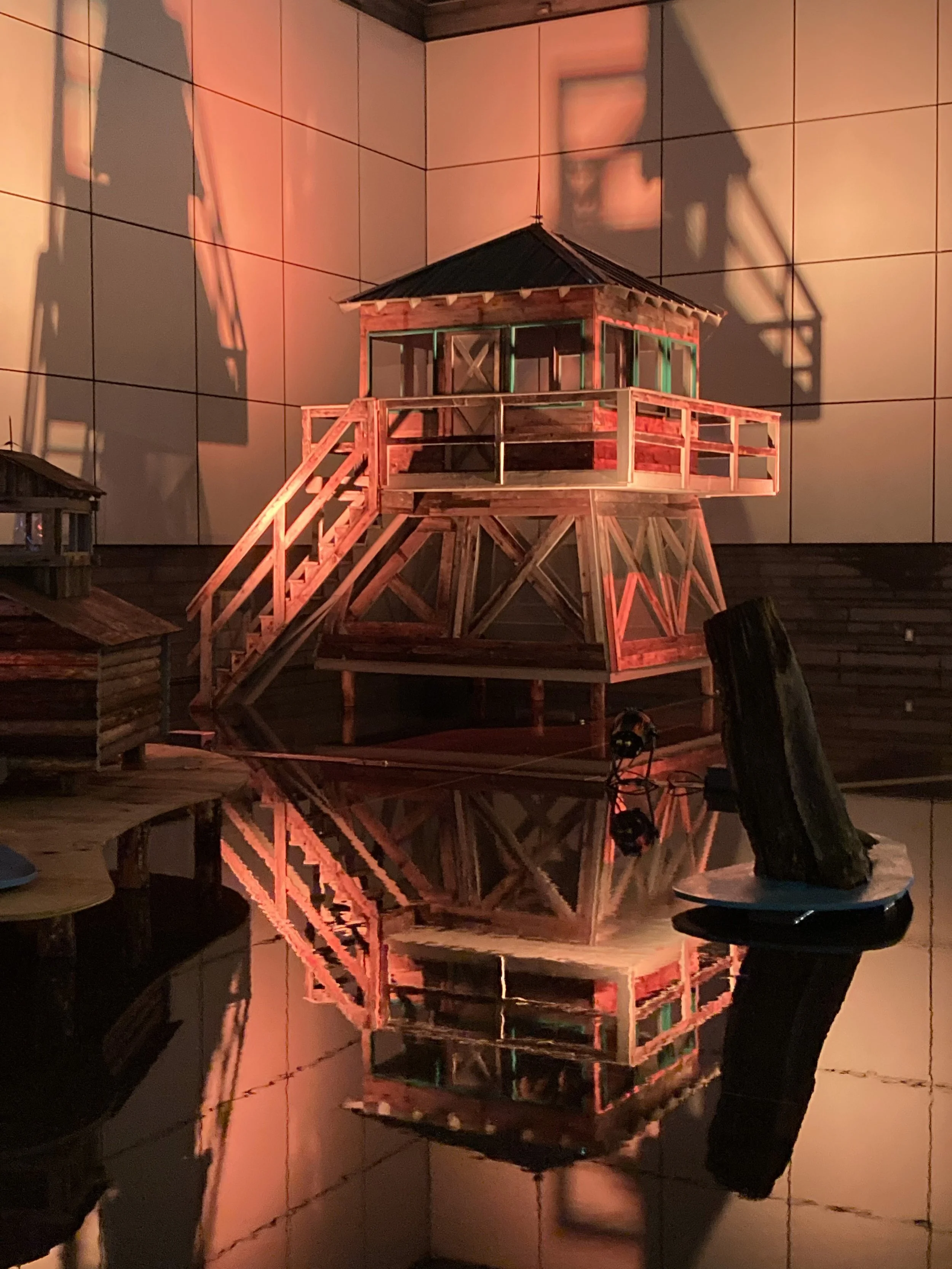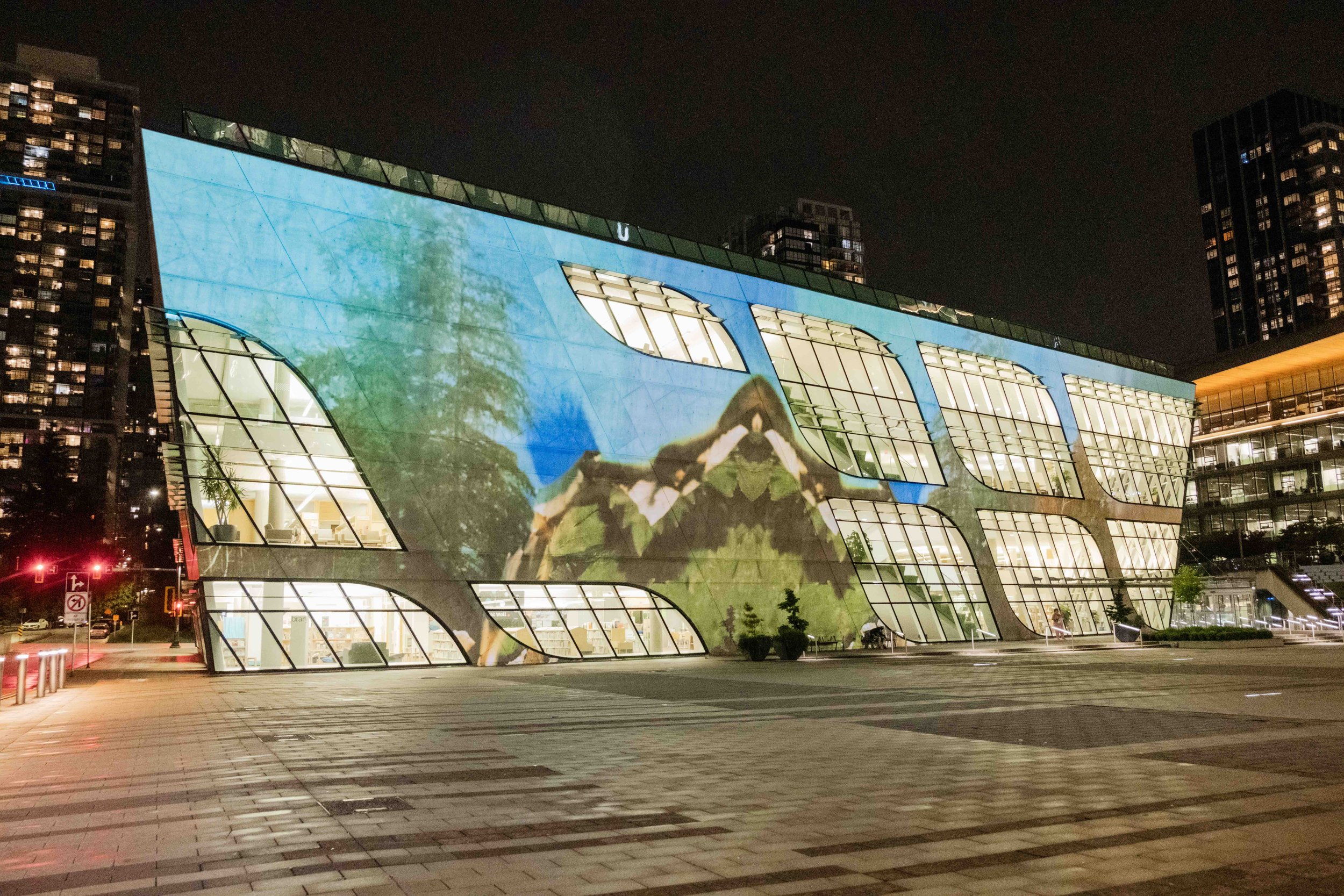Stir Q&A: Keith Langergraber on climate change, isolation, and the creepiness of borders
The Vancouver- and Kelowna-based visual artist hiked to over a dozen fire towers throughout the Pacific Northwest as part of the research behind The Dusk Meridian
Keith Langergraber, The Dusk Meridian. Photo by Liz Wylie
Vancouver Art Gallery Offsite presents The Dusk Meridian at 1100 West Georgia Street to May 23.
THE DUSK MERIDIAN, the latest Vancouver Art Gallery Offsite commission, takes its name from the moment in time between the setting of the sun and the onset of darkness—and from the geographical location of this phenomenon, which traverses the rotating surface of the planet endlessly. The title of the multimedia work by visual artist Keith Langergraber also refers to Cormac McCarthy’s The Blood Meridian: Or the Evening Redness in the West, an apocalyptic neo-Biblical novel set on the border between the U.S. and Mexico.
Langergraber, who splits his time between Vancouver and Kelowna, studied at University of Victoria and University of British Columbia and teaches at Emily Carr University. His research-based work springs from an interest in social, cultural, and political change found through scrutiny of specific sites.
In The Dusk Meridian, curated by Grant Arnold, Audain Curator of British Columbia Art, theatrical light is projected nightly from dusk until dawn onto two fire towers that sit in a shallow pool of water. The work acts as an allegory for crossing a point of no return—the passing from light into darkness.
Stir caught up with Langergraber to hear more.
Had you been working on this project or had it in mind before the devastating wildfires that ripped through the province this past summer? Regardless, what was it about this phenomenon related to the climate crisis that compelled you to create this work?
I had been working on this piece for about a year before the summer of firestorms. Growing up in the Okanagan, fire has always been a lingering presence in my life that comes into my periphery more often now that we are seeing the early destructive manifestations of climate change. I have also been interested in fire towers for some time, experiencing many in my youth into adulthood. These became for me a legitimate way to explore these destructive changes that we are faced with. Usually, fire is a rejuvenating force, but the scale of fire complexes now point to bigger calamities on the horizon.
You're known for applying research-based methodologies to your work. What type of study did you do for this piece?
For research for this project I hiked to at least a dozen fire towers within the Pacific Northwest region, spending the most amount of time at Holdover Peak/Monument 83, a lookout point where two fire towers are situated side by side on either side of the Canada-U.S. border in a remote part of E.C. Manning Provincial Park. I became very interested in this interstitial space. After these often long stretches in the high alpine, I started to posit the space in a more allegorical manner, thinking that these fire towers can be barometers for climate change—lighthouses for catastrophes that have arrived, that are coming and aren’t going anywhere, and that fire is one medium that recognizes no borders.
These borders will come into question when we really start experiencing climate migrations on a large scale.
Small hints at the unsubstantiality of such divides have already come into question locally with water spilling over from the Nooksack river and contributing to the flooding in the Fraser Prairie. I did a lot of archival research as well, studying the building schematics for many fire towers situated throughout the province. I took elements from a few to use as a basis to construct the larger of the two towers. The smaller cupola cabin is quite true to form with the Canadian tower found on Holdover Peak/Monument 83. Both were scaled down, of course, but the research helped me to establish a sliding scale that could be read as accurate but also spatially poetic so as to be interesting for the viewer.
Of course, like the Holdover Peak/Monument 83 location, my representation of the American tower looms over the smaller Canadian one, speaking to our relationship of having such a giant at our doorstep.
The various stunted stumps at the Offsite piece represent the border line cut through burnt forest on either side of the twinned fire towers that stand on each side of the border. Up in the high alpine you could “cross the line”, but who knows? Maybe a drone would be watching.
Aspects of surveillance are there in the piece, less literally perhaps with the subjects of firewatchers coming into play. Whenever I am at a border, even in the alpine, I feel like I am being watched. Some of the experiences I had on the border were strange. I believe there are a lot of unexplainable forces in these border spaces, as so many writers and poets have gravitated towards these spaces.
Keith Langergraber, The Dusk Meridian. Photo by Keith Langergraber
That moment between when the sun sets and darkness falls could be experienced as a peaceful time, though here it seems rather ominous. How do you perceive it?
I see the painterly light cast and moving at the Offsite location as sitting in a space between representing the destructive forces of wildfire at play and a more sombre cascade of light found in a gorgeous sunset opening a space for contemplation and perhaps hope.
Indigenous groups have lived and worked with fire for centuries within a more reciprocal relation than our current model of resource extraction allows. The last 50 years of not letting fires burn themselves out has caused a lot of problems, but this has of course been magnified with global warming.
For me, the light that cascades onto the fire tower personifies the urgency and tension that comes with such large forces at play evoking the apocalyptic sublime, like a Turner painting, but this representation of dusk for me also presents a liminal space where solutions and possibility can comingle, allowing perhaps space for change, maybe even hope.
So rather than depicting dusk as only a stand-in for our state of feeling like we are teetering at the edge of a dark abyss, I hope the work seeds more lingering questions than it answers, especially around the subjects of borders, climate change, and the isolation associated with the vocation of being a fire tower watcher and how that might resonate within these times of COVID.
In looking at your extensive body of work and the way it incorporates real and imagined places, Grant Arnold describes The Dusk Meridian as an extension of your probing into the "failed promises embedded in these spaces". Can you expand on this?
We have a very loaded relationship with the United States, this superpower on the other side of the fence, but for me, I have become more interested in how borders have always given me the willies. I have always found borderlands charged with a nervous energy in a way that I have trouble coming to terms with. It became an artistic itch that I had to scratch or work out through my art. I began to think of the two towers at Holdover Peak as characters through which I could negotiate my own feeling about borders and the failed promises embedded in such spaces. Through the piece I play these two characters/fire towers against each other on a sculptural stage in a poetic manner to personify the false beliefs we’re expected to hold true to around borders.
While making this large-scale, site-specific installation, I also had to be self-reflective in that we have these romances and preconceptions around borders. I did my best to move past these, so it was tricky to balance working with my lighting designer, Sean Arden, to come upon a visual atmosphere that was enticing but still foreboding. This is how I worked past preconceptions around borders and romanticizing high alpine sunsets, even the most beautiful ones that usually come after or during a nearby fire.
Another challenge we worked out was the timing in the lighting change so that it was slow enough to personify the slow change from dusk into dark while still having it register that the light was in fact changing. I think this brought a more meditative and contemplative tone to contrast the darker note found in the work.
To me it was interesting how these fire towers read as watchtowers but I decided to introduce several colder colours, blueish forms to represent two high mountain tarns (small mountain lakes) I visited often in my research in this area. To me, these allowed pauses to emerge within the darker aspects of the work, perhaps visual “moments” of contemplation, reflection, and spaces for this work to move past simply being a eulogy and allow hope to also enter the experience.
These sculptural representations of glacial-carved mountain lakes, I feel, opened up a different sort of temporality in the work particularly against the shifting light evoking deep geological time rather than a fleeting experience. This became a bit more pronounced with the filling of the infinity pond at the location allowing for mirage like reflections of the light, fire towers and stumps. I felt this space of prismatic hybridity contrasted nicely to the stark, rigid geometry of all the large buildings surrounding the piece.
All these different sculptural/painterly temporalities within the piece allowed me to reflect on the vocation of the firewatcher alone, but always on point watching for wisping drifts of smoke on a distant horizon.














